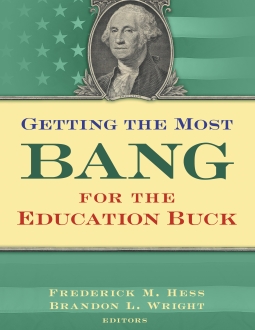Getting the Most Bang for the Education Buck is published by Columbia University’s Teachers College Press and is available for purchase on its website and Amazon.
We spend too much time talking about how much to spend on schools but not enough on how those dollars are spent. Covid-19 has made this situation worse, as schools confront massive, looming budget shortfalls and the challenges of remote learning and public health. That’s on top of familiar issues like pensions, special education, technology, and all the rest.
Is there a workable path through this maze? There is, if you read Getting the Most Bang for the Education Buck, edited by Frederick M. Hess, director of education policy studies at AEI, and Brandon L. Wright, editorial director of the Thomas B. Fordham Institute. Through nine chapters written by a dozen experts in their respective fields, this book provides much-needed guidance to educators and policymakers as they navigate today’s huge fiscal challenges. These include:
- How to rethink staffing and management to get more value for and from employees? Shift toward a team approach where educators fill a variety of crucial roles and are led by the most experienced teachers.
- How to rework pension arrangements to control costs while putting more teacher compensation into take-home pay? States have amassed $500 billion in unfunded public-sector pension debt, and just 7 percent of future health care costs are covered. School districts can address this by paying new teachers more while enrolling them in alternative retirement vehicles and asking staff to pay a standard share of their healthcare costs.
- How to leverage technology as a performance-enhancer? Tech should augment and complement classroom teaching. This can be a boon for staff and students alike, enabling things like science experiments and one-on-one visits with teachers and counselors—even when logistics don’t permit in-person contact.
- How districts might frame spending options differently to meet the needs and preferences of students and families? What if you compute the total per-student cost of education services and ask families, “Would you rather have the usual services or a cash equivalent?” Such a tool would help gauge what services really cost. When families opt for the cash instead, it’s a signal that the value of those services may need reappraising.
Contributors include Chad Aldeman, senior associate partner at Bellwether Education Partners; Bryan Hassel and Emily Ayscue Hassel, co-presidents of Public Impact; Karen Hawley Miles, chief executive officer and president of Education Resource Strategies; Matthew Ladner, executive editor of redefinED; Nathan Levenson, managing director of the District Management Group; Michael Q. McShane, director of national research at EdChoice; Scott Milam, Carrie Stewart, and Katie Morrison-Reed of Afton Partners; Marguerite Roza, director of the Edunomics Lab at Georgetown University; and Adam Tyner, associate director of research at the Thomas B. Fordham Institute.
What others are saying about the book
“Lots of books tell educators what’s wrong with the way they spend their resources. This one tells them how to spend their resources right. As budgets decline post-Covid-19, leaders and policymakers need to know how to make the most of limited resources. This book offers practical solutions to real-world problems like outdated staffing models, declining enrollments, and increasing special education costs, along with frameworks for tackling other tough resource-allocation challenges.”
—Carrie Conaway, senior lecturer on education, Harvard Graduate School of Education
“While greater spending on students is always the ideal, a defining feature of public education is resource scarcity. Hess, Wright, and their colleagues provide a research-driven framework for moving beyond the simple question of whether more money is better to the essential question of the coming era: What is the best way to use the limited dollars we have to meet the needs of all students?”
—Celine Coggins, executive director, Grantmakers for Education
“Education leaders often need fresh insights on entrenched struggles. This book serves as a thought-piece that reveals inspiring new perspectives. And with new perspectives come new and unexpected insights on how to deploy resources in ways that improve outcomes for our students.”
—AJ Crabill, former deputy commissioner, Texas Education Agency
“Starting from the well-established premise that money matters for high-quality K–12 schooling, this thought-provoking book explores ways that policymakers and practitioners might think about how to use their valuable resources effectively and efficiently. This is a worthwhile read for those hoping to better understand the financial predicament of school systems today and to improve outcomes for students and schools when resources are tight.”
—Katharine O. Strunk, professor and Erickson Distinguished Chair, Department of Educational Administration, Michigan State University




